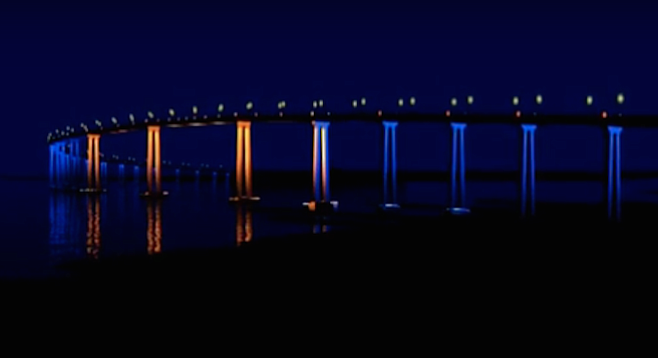 Facebook
Facebook
 X
X
 Instagram
Instagram
 TikTok
TikTok
 Youtube
Youtube

Caltrans is planning a $14.6 million project to rewire the 2.12 mile Coronado bridge and swap the span's incandescent lights for LEDs.
"The majority of the work is under the bridge where people can't see it," said Laura Espinoza, the project manager at Caltrans. "What's there now is the original electrical infrastructure that's 50 years old."
The goal is to upgrade the electrical to lower voltage and to reduce the amount of electricity used, she said. The light poles are mounted on the bridge rail and workers will be removing the lamps' heads and replacing them with LEDs — two of which are already in place as test lights at the Coronado end.
The plan includes replacing electrical equipment at the toll plaza, in a utility building by the bike path on the island, and on the San Diego end, at Pier 19 and at a utility building near the east end of the bridge in Barrio Logan.
The project is out to bid now, she said. And the work will be done at night. Espinoza said the workers use a catwalk under the bridge to do the majority of the rewiring, so drivers shouldn't expect to see them.
"The catwalk is very narrow, about three and a half feet wide," she said. "It's low in a lot of places, you have to duck under stuff a lot."
The electrical work dovetails into a lighting-oriented art project first approved in 2010. The proposed art project includes lighting under the roadway that follows the speed and motion of cars on the bridge as well as lighting on the pillars that can be changed to signify events or seasons or whatever people want.
The Peter Fink team design includes wind turbines to power the installation.
The port district began exploring an idea for an art project for the bridge in 2006, and — after the great recession started to ease up — approved the Fink concept in 2010. They entered into an agreement with Caltrans in 2011 and started looking at funding for the $8 million project in 2012. Money for the project will not come from public dollars, according to port spokeswoman Tanya Castaneda: the San Diego Foundation created a fund to collect donations.
Many of the port's agreements for development and use of land include a commitment by the tenant to fund art. In August, BAE Systems poured $300,000 into the fund, raising the total to $455,000 toward a $750,000 feasibility study. The feasibility study and a complex environmental review, including questions of light pollution affecting people, animals, and bay creatures, is part of the expense, port officials said.


Caltrans is planning a $14.6 million project to rewire the 2.12 mile Coronado bridge and swap the span's incandescent lights for LEDs.
"The majority of the work is under the bridge where people can't see it," said Laura Espinoza, the project manager at Caltrans. "What's there now is the original electrical infrastructure that's 50 years old."
The goal is to upgrade the electrical to lower voltage and to reduce the amount of electricity used, she said. The light poles are mounted on the bridge rail and workers will be removing the lamps' heads and replacing them with LEDs — two of which are already in place as test lights at the Coronado end.
The plan includes replacing electrical equipment at the toll plaza, in a utility building by the bike path on the island, and on the San Diego end, at Pier 19 and at a utility building near the east end of the bridge in Barrio Logan.
The project is out to bid now, she said. And the work will be done at night. Espinoza said the workers use a catwalk under the bridge to do the majority of the rewiring, so drivers shouldn't expect to see them.
"The catwalk is very narrow, about three and a half feet wide," she said. "It's low in a lot of places, you have to duck under stuff a lot."
The electrical work dovetails into a lighting-oriented art project first approved in 2010. The proposed art project includes lighting under the roadway that follows the speed and motion of cars on the bridge as well as lighting on the pillars that can be changed to signify events or seasons or whatever people want.
The Peter Fink team design includes wind turbines to power the installation.
The port district began exploring an idea for an art project for the bridge in 2006, and — after the great recession started to ease up — approved the Fink concept in 2010. They entered into an agreement with Caltrans in 2011 and started looking at funding for the $8 million project in 2012. Money for the project will not come from public dollars, according to port spokeswoman Tanya Castaneda: the San Diego Foundation created a fund to collect donations.
Many of the port's agreements for development and use of land include a commitment by the tenant to fund art. In August, BAE Systems poured $300,000 into the fund, raising the total to $455,000 toward a $750,000 feasibility study. The feasibility study and a complex environmental review, including questions of light pollution affecting people, animals, and bay creatures, is part of the expense, port officials said.
Comments